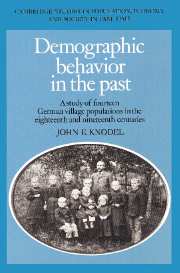 Demographic Behavior in the Past
Demographic Behavior in the Past Published online by Cambridge University Press: 04 August 2010
The preceding chapters have surveyed demographic behavior in 14 German village populations during the eighteenth and nineteenth centuries, based on reconstituted family histories included in village genealogies. They illustrate the distinctive value of micro-level data derived through family reconstitution for the study of population processes in the past, and in particular for the study of demographic transition. Most of the findings would have been impossible to obtain from conventional sources of demographic data, such as published census tabulations and vital statistics. Not only do such data not exist for much of the period covered, but since such data are already aggregated in the source, they do not permit analyses which interrelate different aspects of demographic behavior at the individual or family level. In addition, much important information known about individuals covered in a family reconstitution study derives from the reconstitution process itself. Thus information often not available from standard demographic sources, such as a child's birth order, the interval between births, or a mother's age at a particular confinement, can be determined through family reconstitution because the vital events of a family have been linked together.
Aggregate analysis of parish records is also much more limited in the extent of information provided and the extent to which such data permits the exploration of interrelationships. While there have been major methodological advances in this approach, as illustrated by the recent study of the population history of England by Wrigley and Schofield, aggregative analysis still provides only the most basic demographic measures for a population.
To save this book to your Kindle, first ensure [email protected] is added to your Approved Personal Document E-mail List under your Personal Document Settings on the Manage Your Content and Devices page of your Amazon account. Then enter the ‘name’ part of your Kindle email address below. Find out more about saving to your Kindle.
Note you can select to save to either the @free.kindle.com or @kindle.com variations. ‘@free.kindle.com’ emails are free but can only be saved to your device when it is connected to wi-fi. ‘@kindle.com’ emails can be delivered even when you are not connected to wi-fi, but note that service fees apply.
Find out more about the Kindle Personal Document Service.
To save content items to your account, please confirm that you agree to abide by our usage policies. If this is the first time you use this feature, you will be asked to authorise Cambridge Core to connect with your account. Find out more about saving content to Dropbox.
To save content items to your account, please confirm that you agree to abide by our usage policies. If this is the first time you use this feature, you will be asked to authorise Cambridge Core to connect with your account. Find out more about saving content to Google Drive.